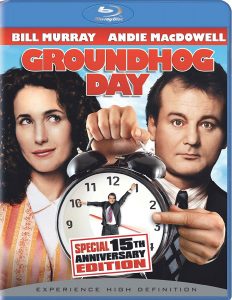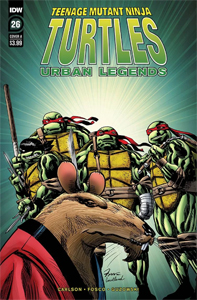When “Teenage Mutant Ninja Turtles” Volume 3 (Image Comics) was cancelled in 1999 with Issue 23, just a few issues before writer Gary Carlson could finish his plot threads and character arcs, everyone assumed that would be the end of it. In 1999, canceled meant canceled.
In the 21st century, nothing is truly canceled – and mostly that’s a good thing. First, “TMNT” superfan Andrew Modeen – who as a teen had fan letters published in the Image comics – wrapped up the saga by writing Issues 24-25 in 2011-12, incorporating Carlson’s notes about the unfinished story points and recruiting Arsniy Dubakov for art duties. That project was cool, and I assumed it would be all we’d get.
Then in 2020, IDW hired Carlson to write the official finale, with Issues 24-26. For “TMNT” fans, this has to rank as the coolest example of “nothing is truly canceled.” (While these issues “overwrite” Modeen’s work, IDW gives him credit for inspiring the project, plus artist Frank Fosco duplicates one of Dubakov’s splash pages.)

“Teenage Mutant Ninja Turtles: Urban Legends” (Image Volume 3) Issues 24-26 (2020)
IDW Comics
Writer: Gary Carlson
Pencils and inks: Frank Fosco
Colors: Adam Guzowski
The reprints of Image’s Issues 1-23, plus the three new issues, are in color and rebranded as “Urban Legends.” The snarky title refers to the city-based action in Mirage’s New York and Image’s Chicago and Midway City, where the Turtles venture in the middle batch of issues.
It’s also a nod to the fact that Peter Laird declared Image “non-canon” in relation to his Volume 4 and the fact that some fans loathed the Image comics for turning Don into a cyborg, Raph into the Shredder, and for Leo getting his hand bitten off.
Dueling identities
It could also be subtitled “Identity Theft,” as almost every character searches for self amid technological, spiritual and everyday hijackings of their lives. I reread the series to experience it as a whole, and identity emerges as Carlson’s core theme, even without the three concluding issues. But the grand finale does ask one major question of identity: “Who is Lady Shredder?”
The answer is different from Modeen’s issues (even though he used Carlson’s notes) but similar. Hint: It involves sentient nanotech that can take over bodies, even well-preserved corpses. It’s a neat twist to have a different answer from Modeen’s (wherein Shredder’s ex-girlfriend and mother of Pimiko is Lady Shredder), even if this one isn’t as epic in terms of overall lore.
Modeen gives a darker spin and heavily incorporates Volume 4, notably setting the stage for the Utrom visitation of Earth. Carlson sticks to his personal vision – as if he’s still writing in 1999 — and focuses on what the events mean to the characters. For example, Leo refuses to accept a nanotech-based hand after seeing Don’s internal battles for selfhood.

While these “search for identity” points are wrapped up, I would’ve liked to have read even more about the tolls they take. Splinter is possessed by an evil Foot Clan sorcerer via the Astral Plane, and the ninja master is definitely physically exhausted by this. But I never quite gasp how these internal takeovers feel to Don and Splinter. Mirage would’ve internalized these struggles, but Carlson’s strengths lie elsewhere, and ultimately it’s good to have variety.
A breakout character
Carlson nicely uses the Foot Clan throughout the saga to illustrate different kinds of “honor” – ultimately the bad kind – and contrast that with truly honorable people. This latter batch includes, surprisingly, Pimiko.
She ends up being both a memorably designed villainess – with a skimpy costume that allows freedom of movement and draws quips from the Turtles – and a well-written heroine, as her sense of honor causes her to switch sides. Considering the identity theme, though, it would’ve been nice to see the face behind the mask (as we do in Modeen’s project) once she finds her true purpose on the side of good.
Another strong villain (who maybe isn’t a villain), King Komodo, also gets his arc wrapped up, although the narrative could’ve used more hints about his evil brother. Modeen’s story doesn’t incorporate this, making me wonder if it’s a new invention from Carlson.
The Turtles … now in full color!
Fosco continues to be a fine artist, particularly as a penciler more so than as an inker. Fans of the action scenes from Eastman and Laird will feel underwhelmed, but those two are among the all-time elite fight-scene artists.
Depending on the inker from month to month, a readers’ ability to clearly grasp Volume 3’s in-panel action varies (although the panel-to-panel pacing is always energetic). Eastman’s duotones are missed throughout the run. (Carlson’s clear storytelling – plus the way the Turtles are easily distinguished with their new traits – make the stories easy to follow, though.)
Colorizing the Image run isn’t merely a gimmick by IDW, but a wise artistic choice. Adam Guzowski’s colors often improve the book, particularly on the issues that aren’t as well inked. I chose to keep my B&W issues and view the colorizations in digital check-outs from my library, while purchasing only the three new issues.
But the Image issues are getting pricey, so a newcomer to the series can feel good getting this overlooked but excellent “TMNT” story under the “Urban Legends” banner – either as individual issues or in two trade paperbacks.
More resurrections in the future?
Hopefully “Urban Legends” was a commercial success for IDW in addition to being an artistic success, because then the publisher might be open to giving longtime fans other holy grails of “Not Canceled After All.” The next big one is Laird’s Volume 4, a “lost volume” in even more extreme fashion than Volume 3.
Volume 4 ended with a cliffhanger in Issue 32, in this case because Laird lost interest in continuing the yarn, not because of cancellation. Plus, many issues are impossible to find for affordable prices (and some are digital-only). So a reprint – colorized or otherwise – would be welcome. Laird is retired, but perhaps he’d be willing to share his story notes with a new writer who could produce a few concluding issues.
It’s unlikely, but — after the “Urban Legends” project — not impossible.

